This post may contain affiliate links. Please read our
disclosure policy
for more information.
Am I the only one who’s found themself standing in front of the fridge at midnight, tortilla chip in hand, contemplating if that jar of salsa verde is still my friend or has crossed over to the dark side? (Please tell me I’m not the only one.)
Once you indulge, that’s it. Before you know it, that vibrant green sauce has snuck its way into snacking rituals, taco nights, and burrito bowl bashes. Made from a blend of fresh tomatillos, white onion, serrano peppers (or jalapeño peppers), garlic cloves, and a handful of fresh cilantro, this delicious dip has roots in Mexican cuisine, but quickly became an around-the-globe table favorite.
And because we love slathering it on everything from tortilla chips to grilled chicken, it’s only right that we ask ourselves the big question: How long can salsa verde keep its cool in the fridge before turning into a science experiment?
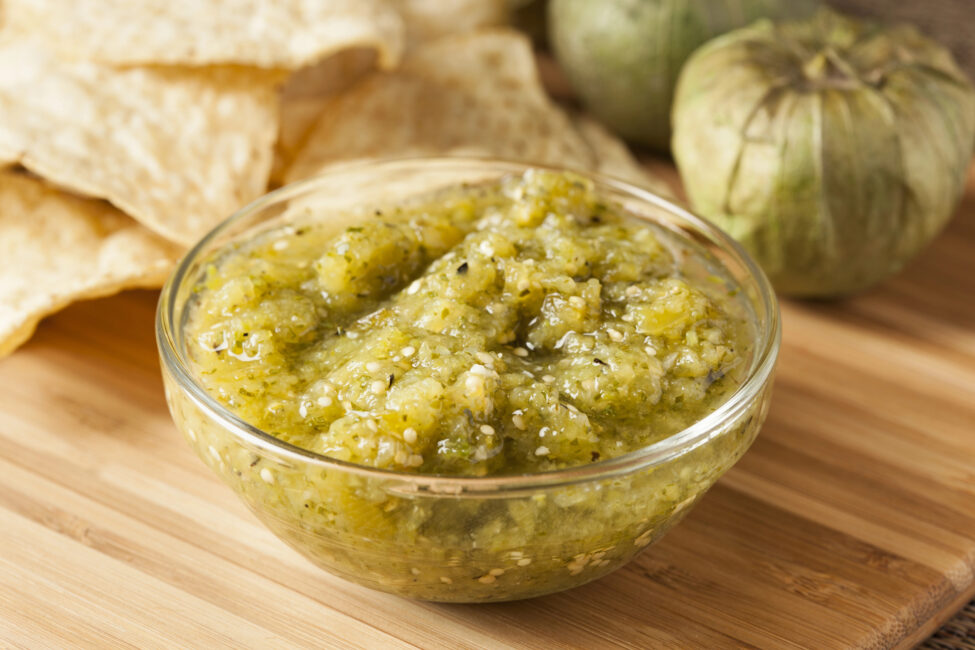
The Quick Scoop: Shelf Life of Salsa Verde
So, you whipped up your own salsa verde or grabbed a jar from the grocery store, and now you’re wondering how long the magic will last. The short answer? Homemade salsa verde will keep its zing in the fridge for about 5-7 days, if stored properly in an airtight container. Store-bought salsa verde may last a bit longer, up to two weeks, thanks to the extra preservatives they often contain.
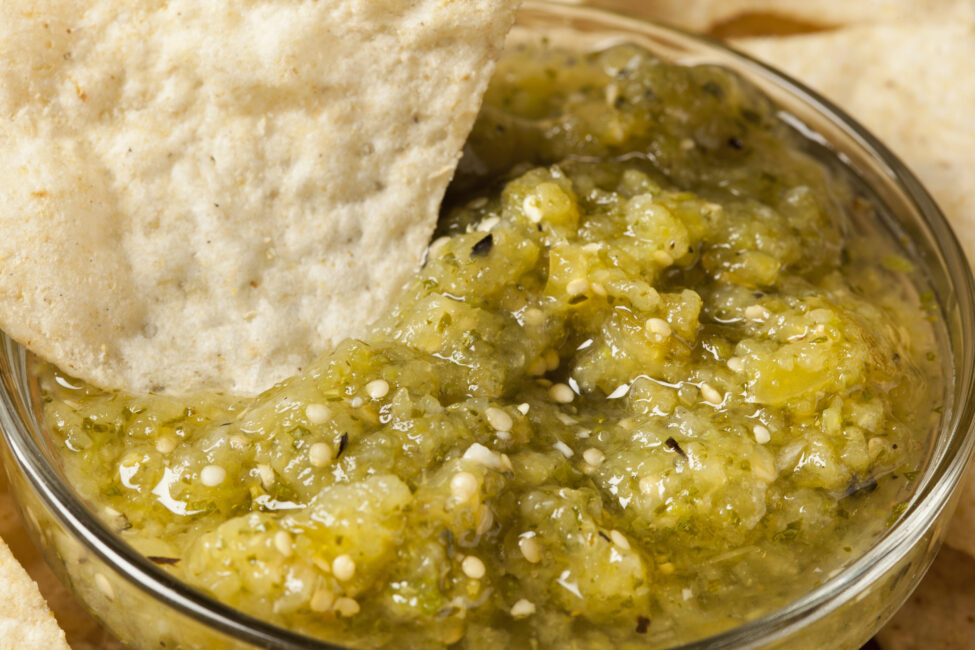
How Certain Ingredients Help Keep Your Salsa Fresh
For the homemade variety, the freshness of salsa verde is often dependant on the ingredients you use.
The star of our salsa verde show is the tomatillo, a little green fruit that’s part of the nightshade family. With the help of (other main ingredient) lime juice, which contains high acidity levels, you reap the natural preservative benefits of these ingredients. Acidity creates an environment that’s not very welcoming for bacteria, which is why dishes with higher acid content tend to last longer in the fridge.
If you’re someone who likes to add a little oil and/or vinegar to your salsa verde, whether that’s olive oil, avocado oil, or even red wine vinegar, then you can take advantage of not only the extra flavor these bring, but also the natural antibacterial properties of these additions.
The Shelf Life of Homemade vs. Store-Bought Salsa Verde
Though homemade salsa verde stays fresh for about 5-7 days with proper storage, store-bought salsa verde can often hang out comfortably for up to two weeks, sometimes a smidge longer, due to its added preservatives.
HOWEVER: The shelf life of your salsa, whether DIY or from the Mexican cuisine aisle, depends greatly on storage conditions. Let’s get into how to keep it fresh.
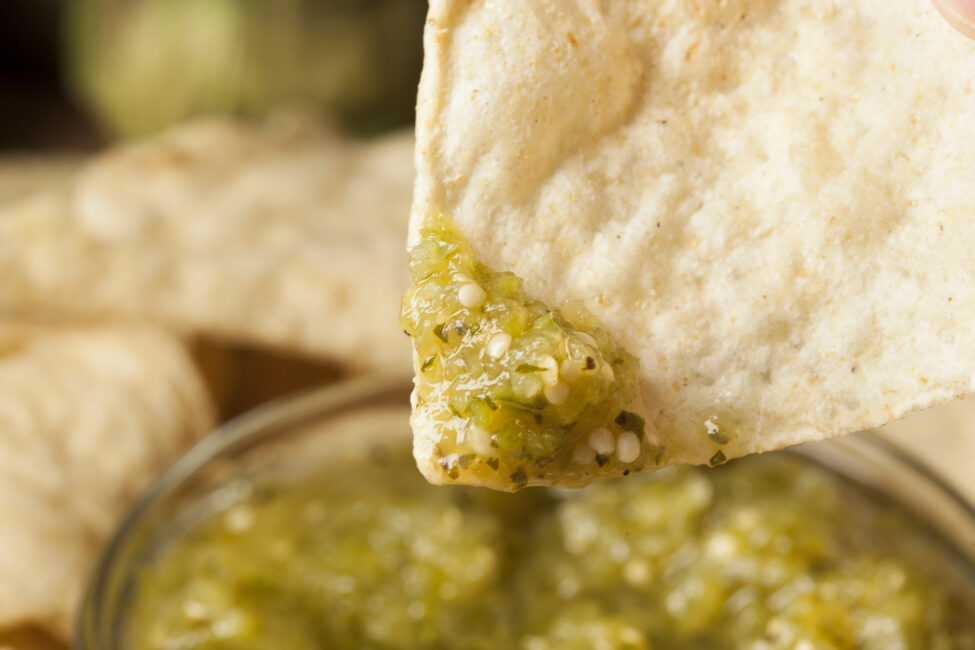
Storing Salsa Verde: Tips to Maximize Freshness
Keeping your salsa verde as fresh as the day it was made (or bought) is easy-peasy-lemon-(or lime?)-squeezy. Here are some tips for keeping it zesty:
- Containers: Mason jars or any airtight containers can be your best friends when storing salsa. They keep the air and bacteria out and all the delicious flavors in. Also, sealing your container tightly sealing your salsa verde is the best way to prevent those gross fridge odors from ruining the vibrant flavors of your Mexican green salsa.
- Avoid Room Temp Conditions: We get it, your salsa verde is irresistible. But leaving it out at room temperature is the surest way to significantly cut its shelf-life down. Keep it cold as long as possible, and only use as much as you’re going to need at one time.
- Cross-Contamination: Double-dipping or using a spoon that’s touched other foods is a no-go. Why? Because bacteria love to mingle. If you want to keep your salsa fresh, designate a utensil that is only meant to transfer salsa from the main bowl to individual plates. Refrain from putting a container of salsa that’s been sullied by a bunch of chips back in the fridge, unless you want a penicillin party.
Signs of Salsa Gone Bad
Even the best parties must come to an end, and your salsa verde shindig is no exception. Here’s when you know it’s time to bid adieu to this green goddess:
- Smell: If your salsa starts giving off a funky odor that’s more “science experiment” than “fiesta,” it’s time to let go. Adios!
- Color: Salsa verde should be a lively green, not a dull brown. No comas eso. (Don’t eat that.)
- Textures: If the texture has gone from saucy to soupy or it looks like it’s separating, it’s time to chuck it.
- Food Safety First: Remember, when in doubt, throw it out. No taste test is worth a bout of foodborne illness. We know it’s hard to say goodbye, but trust your eyes and nose in this case, not your hopeful heart.
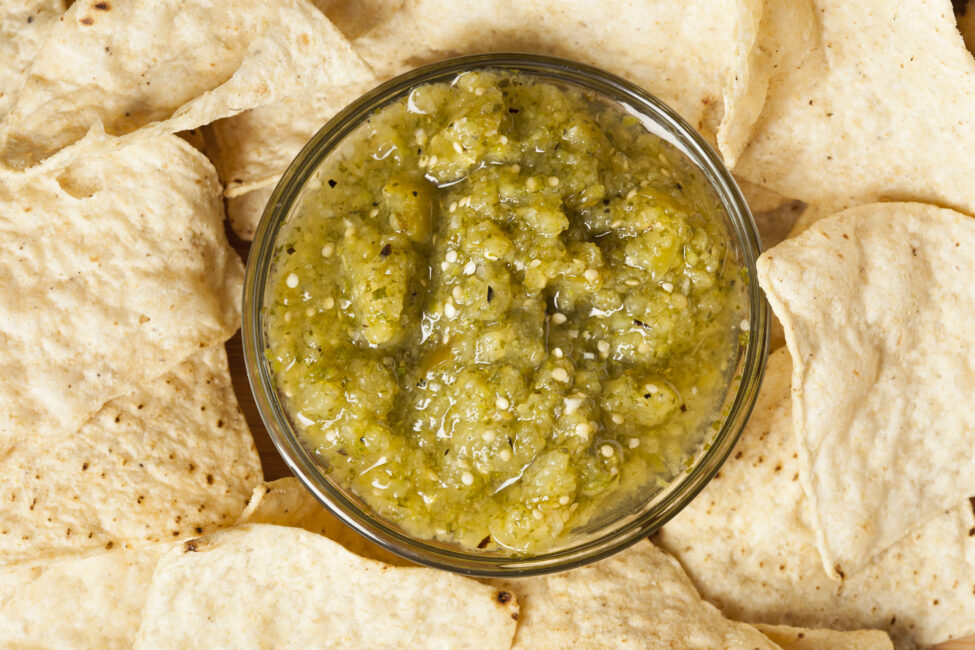
Can I Freeze Salsa Verde?
You got a little too excited and you made WAY too much salsa verde. Happens to the best of us. And now you’re wondering… “Can I freeze this?” The answer is a resounding “Yes! However…”
Here’s the scoop on freezing salsa:
- Texture Change: When you put salsa verde freezer, the water content can form ice crystals. And once thawed, these crystals can make your salsa a bit more watery than its original, vibrant self. A quick stir MIGHT bring it back to life, but it’s something to keep in mind.
- Flavor Change: Freezing has been known slightly dull the fresh flavors of salsa verde. It might not be a deal-breaker, but your salsa might need a squeeze of fresh lime juice or a dash of salt to zhuzh it up once you thaw it out.
- Best Ways To Freeze: The easiest way to freeze salsa verde is in small portions. Think ice cube trays or small freezer-safe containers. This way, you can thaw just what you need without defrosting the whole batch.
Pro Tip: If you’ve made a roasted tomatillo salsa, the roasting process may actually help your salsa fare better in the freezer. This is due to the deeper flavors and reduced water content.
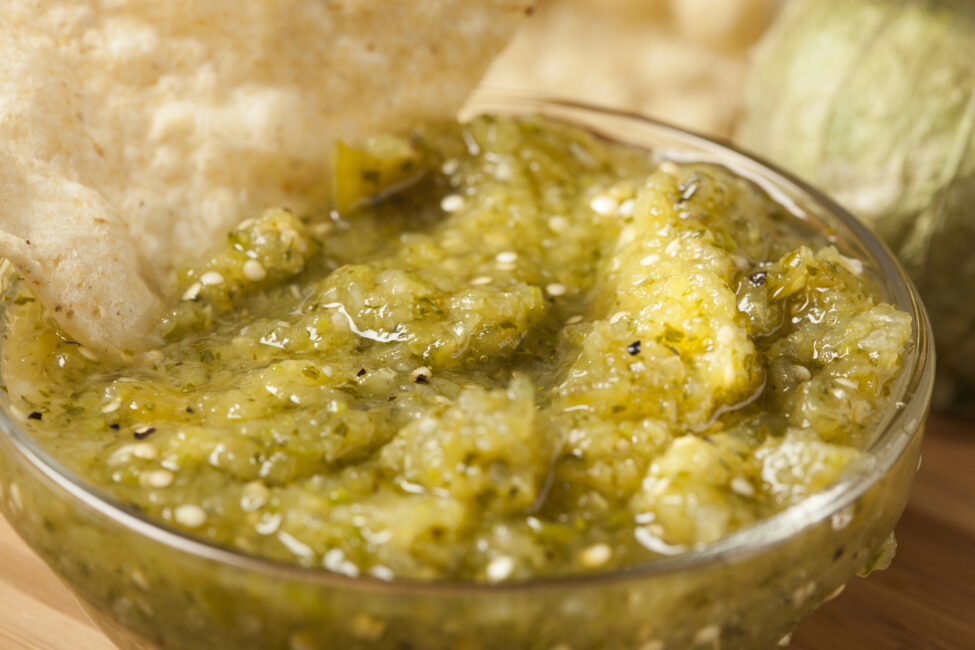
FAQ
Can I make salsa verde without a food processor?
Absolutely! A good old-fashioned blender or even a mortar and pestle will do the trick. As long as you can blend those fresh ingredients, you’re all good!
Is there a difference between Mexican salsa verde and Italian salsa verde?
Yup! Mexican salsa verde is a tangy, tomatillo-based sauce with chili peppers, cilantro, and lime juice. The Italian version, on the other hand, is a non-spicy, more herb-oriented dip featuring parsley, capers, garlic, and lemon juice or vinegar. Their flavor profiles are very different.
Can salsa verde be used as more than just a dip?
Salsa verde is much like a chameleon. It blends in seamlessly among a variety of food environments. Of course, it makes for a delicious dip for tortilla chips, BUT ALSO! It’s fantastic in burrito bowls, drizzled over grilled meats, or swirled into scrambled eggs. We encourage you to experiment with this bold little sauce and let us know where you think it fits best!
Tell Us Your Salsa Stories!
The salsa conversation doesn’t end here. We know some of you are holding onto secret family recipes and innovative twists. Whatever it is, we’re all ears!
Tell us your best salsa verde tips, tricks, and tales in the comments below.
Looking for More Fridge Tips?
This post may contain affiliate links. Please read our
disclosure policy
for more information.
This post may contain affiliate links. Please read our
disclosure policy
for more information.
Am I the only one who’s found themself standing in front of the fridge at midnight, tortilla chip in hand, contemplating if that jar of salsa verde is still my friend or has crossed over to the dark side? (Please tell me I’m not the only one.)
Once you indulge, that’s it. Before you know it, that vibrant green sauce has snuck its way into snacking rituals, taco nights, and burrito bowl bashes. Made from a blend of fresh tomatillos, white onion, serrano peppers (or jalapeño peppers), garlic cloves, and a handful of fresh cilantro, this delicious dip has roots in Mexican cuisine, but quickly became an around-the-globe table favorite.
And because we love slathering it on everything from tortilla chips to grilled chicken, it’s only right that we ask ourselves the big question: How long can salsa verde keep its cool in the fridge before turning into a science experiment?

The Quick Scoop: Shelf Life of Salsa Verde
So, you whipped up your own salsa verde or grabbed a jar from the grocery store, and now you’re wondering how long the magic will last. The short answer? Homemade salsa verde will keep its zing in the fridge for about 5-7 days, if stored properly in an airtight container. Store-bought salsa verde may last a bit longer, up to two weeks, thanks to the extra preservatives they often contain.

How Certain Ingredients Help Keep Your Salsa Fresh
For the homemade variety, the freshness of salsa verde is often dependant on the ingredients you use.
The star of our salsa verde show is the tomatillo, a little green fruit that’s part of the nightshade family. With the help of (other main ingredient) lime juice, which contains high acidity levels, you reap the natural preservative benefits of these ingredients. Acidity creates an environment that’s not very welcoming for bacteria, which is why dishes with higher acid content tend to last longer in the fridge.
If you’re someone who likes to add a little oil and/or vinegar to your salsa verde, whether that’s olive oil, avocado oil, or even red wine vinegar, then you can take advantage of not only the extra flavor these bring, but also the natural antibacterial properties of these additions.
The Shelf Life of Homemade vs. Store-Bought Salsa Verde
Though homemade salsa verde stays fresh for about 5-7 days with proper storage, store-bought salsa verde can often hang out comfortably for up to two weeks, sometimes a smidge longer, due to its added preservatives.
HOWEVER: The shelf life of your salsa, whether DIY or from the Mexican cuisine aisle, depends greatly on storage conditions. Let’s get into how to keep it fresh.

Storing Salsa Verde: Tips to Maximize Freshness
Keeping your salsa verde as fresh as the day it was made (or bought) is easy-peasy-lemon-(or lime?)-squeezy. Here are some tips for keeping it zesty:
- Containers: Mason jars or any airtight containers can be your best friends when storing salsa. They keep the air and bacteria out and all the delicious flavors in. Also, sealing your container tightly sealing your salsa verde is the best way to prevent those gross fridge odors from ruining the vibrant flavors of your Mexican green salsa.
- Avoid Room Temp Conditions: We get it, your salsa verde is irresistible. But leaving it out at room temperature is the surest way to significantly cut its shelf-life down. Keep it cold as long as possible, and only use as much as you’re going to need at one time.
- Cross-Contamination: Double-dipping or using a spoon that’s touched other foods is a no-go. Why? Because bacteria love to mingle. If you want to keep your salsa fresh, designate a utensil that is only meant to transfer salsa from the main bowl to individual plates. Refrain from putting a container of salsa that’s been sullied by a bunch of chips back in the fridge, unless you want a penicillin party.
Signs of Salsa Gone Bad
Even the best parties must come to an end, and your salsa verde shindig is no exception. Here’s when you know it’s time to bid adieu to this green goddess:
- Smell: If your salsa starts giving off a funky odor that’s more “science experiment” than “fiesta,” it’s time to let go. Adios!
- Color: Salsa verde should be a lively green, not a dull brown. No comas eso. (Don’t eat that.)
- Textures: If the texture has gone from saucy to soupy or it looks like it’s separating, it’s time to chuck it.
- Food Safety First: Remember, when in doubt, throw it out. No taste test is worth a bout of foodborne illness. We know it’s hard to say goodbye, but trust your eyes and nose in this case, not your hopeful heart.

Can I Freeze Salsa Verde?
You got a little too excited and you made WAY too much salsa verde. Happens to the best of us. And now you’re wondering… “Can I freeze this?” The answer is a resounding “Yes! However…”
Here’s the scoop on freezing salsa:
- Texture Change: When you put salsa verde freezer, the water content can form ice crystals. And once thawed, these crystals can make your salsa a bit more watery than its original, vibrant self. A quick stir MIGHT bring it back to life, but it’s something to keep in mind.
- Flavor Change: Freezing has been known slightly dull the fresh flavors of salsa verde. It might not be a deal-breaker, but your salsa might need a squeeze of fresh lime juice or a dash of salt to zhuzh it up once you thaw it out.
- Best Ways To Freeze: The easiest way to freeze salsa verde is in small portions. Think ice cube trays or small freezer-safe containers. This way, you can thaw just what you need without defrosting the whole batch.
Pro Tip: If you’ve made a roasted tomatillo salsa, the roasting process may actually help your salsa fare better in the freezer. This is due to the deeper flavors and reduced water content.

FAQ
Can I make salsa verde without a food processor?
Absolutely! A good old-fashioned blender or even a mortar and pestle will do the trick. As long as you can blend those fresh ingredients, you’re all good!
Is there a difference between Mexican salsa verde and Italian salsa verde?
Yup! Mexican salsa verde is a tangy, tomatillo-based sauce with chili peppers, cilantro, and lime juice. The Italian version, on the other hand, is a non-spicy, more herb-oriented dip featuring parsley, capers, garlic, and lemon juice or vinegar. Their flavor profiles are very different.
Can salsa verde be used as more than just a dip?
Salsa verde is much like a chameleon. It blends in seamlessly among a variety of food environments. Of course, it makes for a delicious dip for tortilla chips, BUT ALSO! It’s fantastic in burrito bowls, drizzled over grilled meats, or swirled into scrambled eggs. We encourage you to experiment with this bold little sauce and let us know where you think it fits best!
Tell Us Your Salsa Stories!
The salsa conversation doesn’t end here. We know some of you are holding onto secret family recipes and innovative twists. Whatever it is, we’re all ears!
Tell us your best salsa verde tips, tricks, and tales in the comments below.
Looking for More Fridge Tips?
This post may contain affiliate links. Please read our
disclosure policy
for more information.










